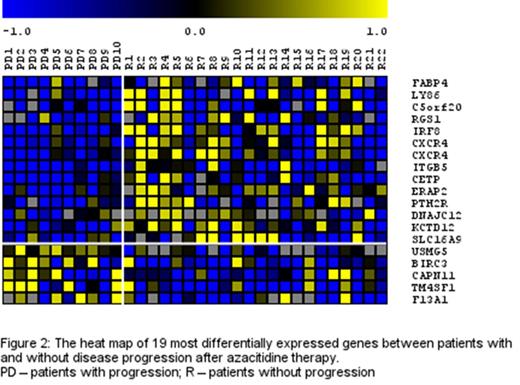Abstract
Background:
Standard therapies for patients with higher-risk myelodysplastic syndromes (MDS) include the hypomethylating agents as azacitidine (AZA) and decitabine, of which they benefit significantly. However, the therapy is effective only in 60% of patients. The aim of the project was to identify patients in whom demethylating therapy might be appropriate.
Methods:
We performed gene expression and methylation profiling in parallel in CD34+ cells from 33 MDS patients before AZA treatment. Control group included 10 healthy individuals. HumanMethylation27 BeadChips and HumanHT-12 v4 Expression BeadChips (Illumina) were used to generate the profiles. DNA and RNA were isolated from the same CD34+ cells separated from bone marrow by magnetic beads. The expression data were preprocessed in lumi package. T-test was applied for differential expression testing. The method of Holm was employed to adjust p-values for multiple comparisons. COHCAP package was used to study differential methylation of the individual genome sites. Beta-values of statistics were considered.
Results:
We used gene expression and methylation profiling methods to identify predictors of therapy response and prognosis. Overall, 10 patients (30.3%) showed progression (PD), 9 (27.3%) had stable disease (SD), and 14 (42.4%) achieved complete (CR) or partial remission (PR). There were no differences between clinical parameters of these groups before administration of the treatment. The main efficacy indicator of the therapy was duration of overall survival, CR was not the main criterion. Therefore, we divided the patients into two groups for further analysis: patients with and without disease progression. Median survival after initiation of AZA treatment in PD was 11.1 months and in other groups was 25.9 months (Fig. 1). Comparison of gene expression levels between the groups revealed 110 differentially expressed probes (FC >1.5; p<0.05) related to following biological processes (according to the DAVID database): immune response (14 genes), cellular response to stress (12), DNA metabolic process (10), and response to DNA damage stimulus (9).We found affected Mismatch repair pathways (p<0.05). Among the most deregulated genes were F13A1, AR, TM4SF1 and BIRC3 withincreased expression and CXCR4, IRF8, LY86 and FABP4 genes with decreased expression (Fig. 2). Between the patient groups, we found significant differences in methylation status only in 5 genes (p<0.05), namely CLP24, LILRA4, KCNS2, DAAM2 and DBC1 genes. None of the genes showed a negative correlation between the expression and methylation status. Most of these deregulated genes are associated with a worse prognosis in AML.
Conclusions:
Although the data in our study still require a more comprehensive examination in a larger confirmative cohort of patients, the genomic signatures we detected before hypomethylation therapy may help to stratify patients regarding their response to treatment and thus optimize use of hypomethylating agents in order to achieve maximal benefit. Based on the altered expression and methylation status of AML-related genes, we assume that if a certain degree of the progression process has already started in the patient with MDS, azacitidine therapy is no longer effective.
Supported by grant (NT/13899, NT/14377, NT/14539, NT/13847), the project for conceptual development of research organization (00023736) MHCZ and CZ.2.16/3.1.00/28007.
No relevant conflicts of interest to declare.
Author notes
Asterisk with author names denotes non-ASH members.



This feature is available to Subscribers Only
Sign In or Create an Account Close Modal